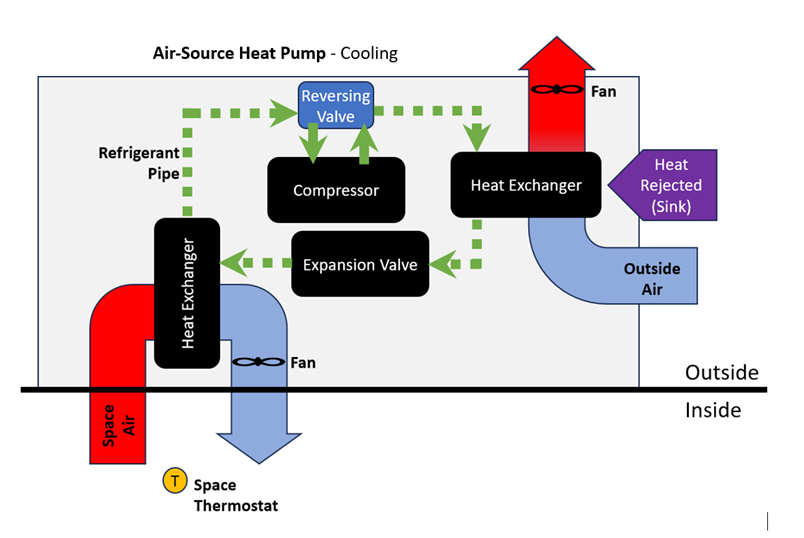What is an air-source heat pump?
Air-source heat pumps can operate efficiently in most climates without relying on fossil fuels, making them a great option for markets whose priority is decarbonization and energy efficiency.
Air-Source Heat Pump
In an air-source heat pump, air is the medium to which heat is absorbed or rejected via the heat exchangers. There is a need for two fans in this unit, one dedicated to moving the air to and from the space airstream and the other for moving air over the outside coil.
When the space thermostat indicates that the space requires cooling, the heat exchanger located in the space air stream has cold refrigerant flowing through it enabling it to absorb heat from the air as it passes over it. The cooled air is then delivered to the space (air conditioning). The heat absorbed by the refrigerant is then transferred via the DX cycle and expelled to the atmosphere through the heat exchanger located in the outside airstream, serving as the heat sink. This process removes the heat from the space and rejects it into the atmosphere.
These units are commonly located outside though and subjective to outdoor temperatures. Outside air temperatures can impact the efficiency and capacity of the DX cycle since it becomes increasingly difficult to absorb heat from really cold air or to reject heat into extremely hot air. A common concern for an air-source heat pump is when the outside air temperatures get low enough that the unit heating capacity becomes compromised and requires additional supplemental heating – such as gas heat - to maintain a comfortable indoor environment. This is something to consider if your top priority is moving away from relying on gas heating.
Looking for guidance or solutions?
Connect with an AAON representative in your area.
👉 Find a Rep Near You
Recent advancements in technology have introduced air-source heat pumps that can operate in lower ambient temperatures than ever before.

When heating is called for by the space, the heat exchangers switch roles by reversing the refrigerant flow direction. The refrigerant entering the coil in the space air stream is now hot and rejects its heat to the cool space air warming it to heat the space. The alternate heat exchanger in the outside air stream now acts to absorb heat from the outside air therefore serving as the heat source.
Packaged Heat Pumps vs Split Systems Heat Pumps
In the commercial HVAC industry, heat pumps come in two different configurations: packaged heat pump and split system heat pump. Packaged heat pumps contain all functional components in a single unit. You will often find these units located outside on top of a building’s rooftop.
A split system heat pump is functionally the same as a packaged heat pump. The difference is a split system heat pump is not contained in a single enclosure but is instead split into two units. One unit containing a heat exchanger and the compressor located outside to reject the system heat to the atmosphere for cooling or absorb the heat from the outside air in the case of heating. The second unit inside contains another heat exchanger, serving the supply air.
Conclusion
In conclusion, air-source heat pumps offer energy efficiency in a decarbonization friendly design. Just remember to look at all the elements that could affect your equipment and its operation. If you select an air-source heat pump with the right design features and options, it can be a comfortable, efficient, and cost saving solution that could last you for years to come.
Have questions or need assistance?
Connect with your local AAON representative for expert guidance and solutions.
👉 Find a Rep Near You